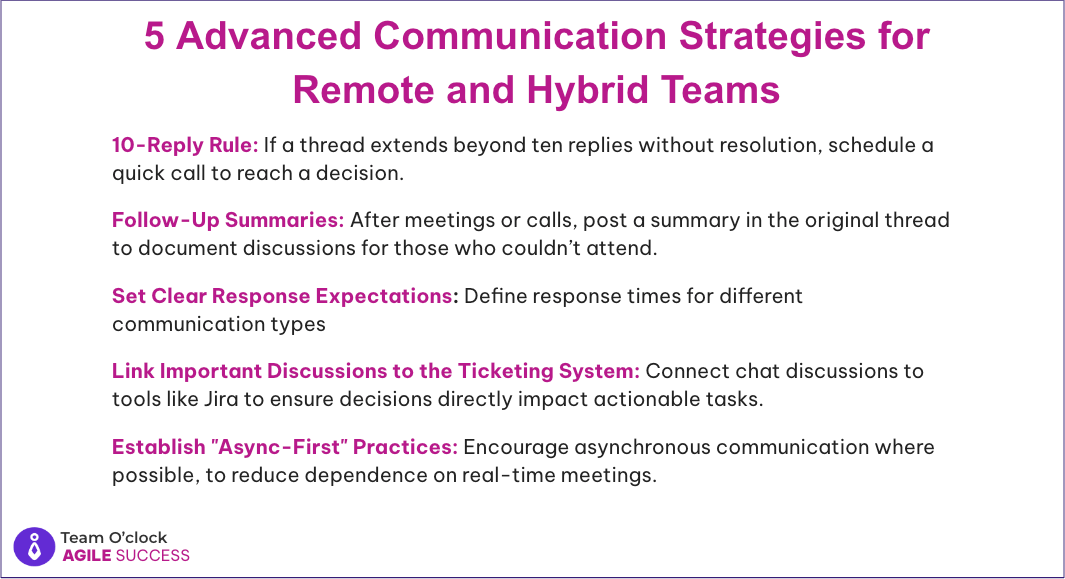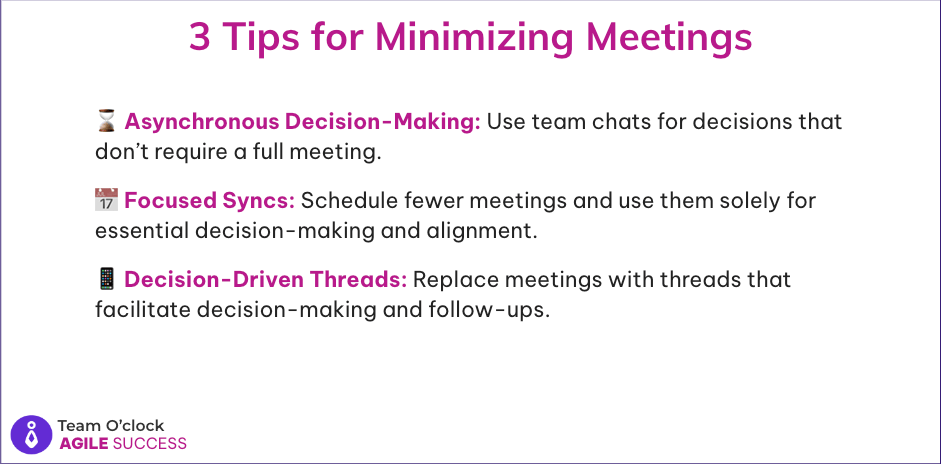
How to Build a Strong Agile Culture in a Remote Environment

Building a strong Agile culture within a remote or hybrid team can be challenging but immensely rewarding. Agile culture thrives on collaboration, transparency, and a continuous improvement mindset—qualities that can seem challenging to nurture across different locations and time zones. However, by optimizing communication and structuring workflows to foster collaboration, dispersed teams can build an Agile environment that boosts productivity and morale.
In a remote environment, communication becomes the backbone of Agile culture. This blog will reveal how to set up efficient communication channels, structure team interactions, and cultivate a collaborative culture to keep Agile values alive, regardless of location.
Why Communication Matters in Agile Teams
Open and transparent communication is essential in Agile, as it builds trust, encourages collaboration, and keeps workflows efficient. In an office setting, this might happen naturally through spontaneous conversations. However, for remote and hybrid teams, communication requires intentional structuring.
Establishing an Agile culture in remote or hybrid teams means empowering everyone to share ideas, ask questions, and provide feedback. A solid communication structure allows Agile teams to work in sync, align goals, and resolve issues in real time. This promotes the trust and transparency required for success in a remote work environment.
How to Optimize Your Communication Channels
Creating a designated communication hub is crucial for effectively managing communication in a remote Agile team. Work chat platforms like Slack or Microsoft Teams become ground zero for collaboration. Keeping the main chat channel private to core team members fosters a safe and open environment, encouraging everyone to contribute.
Setting up clear rules of engagement in the communication hub is equally essential. Here are a few best practices to streamline communication:
Use Threads: Keep all related messages in a single thread for better organization and easier tracking of discussions.
Quick Approvals with Emojis: Encourage using emojis for quick approvals, reducing the need for unnecessary follow-ups.
In-App Reminders: Use reminders to ensure team members stay on track with tasks and follow-ups.
Public Conversations over Direct Messages: Keep conversations in team channels rather than private chats to maintain transparency and information flow.
5 Advanced Communication Strategies for Remote and Hybrid Teams
As remote Agile teams mature, they require more nuanced communication strategies to promote efficiency and collaboration, like the following:

Implementing these strategies encourages asynchronous collaboration, a key aspect of successful remote Agile teams, and provides structure without sacrificing flexibility. This balance is essential for maintaining momentum and alignment within dispersed Agile teams.
How Agile Encourages Proactive Problem-Solving
Agile thrives in an environment where team members are encouraged to approach challenges proactively. Remote teams benefit significantly from a solution-oriented mindset, where problems aren’t just raised—they come with proposed solutions. This approach can dramatically streamline decision-making and improve morale by empowering team members to take ownership of issues.
Lead with Suggested Solutions: When a team member encounters an issue, encourage them to propose a solution in their message. This moves discussions forward and demonstrates respect for everyone’s time.
Foster Respectful Debate: Promote a culture of respectful conversations where alternative ideas are welcomed. This allows team members to explore diverse solutions without fearing criticism.
Grace Hopper’s “Ask for Forgiveness, Not Permission”: In Agile, rapid experimentation and proactive problem-solving are crucial. Encourage team members to proceed with their proposed solutions, especially when they receive no immediate response. This approach can minimize bottlenecks and keep projects moving forward.
How to Reduce the “Meetings Trap”
Too many meetings can hinder productivity and strain remote teams. Agile is about flexibility and efficiency, so minimizing meetings and encouraging asynchronous decision-making aligns well with Agile values.

By reducing the number of meetings, your team can focus more on deliverables, promoting efficiency and productivity in a remote setting.
Cultivating Culture in a Remote or Hybrid World
Building relationships in a remote Agile environment requires intentionality. While in-office teams might naturally form bonds, remote teams need structured activities to foster connection.
Building Strong Relationships: Encourage regular team-building activities, like virtual coffee breaks or check-ins. Simple gestures of connection go a long way in fostering trust and rapport.
Recognize Remote or Hybrid Differences: Some team members may benefit from in-person connections in hybrid setups. Remote teams can create similar bonds by prioritizing communication and collaboration. The key is consistency and inclusiveness—ensure everyone has equal access to team-building opportunities regardless of location.
3 Actionable Steps for Building a Remote/Hybrid Agile Culture
To sustain a remote Agile culture, teams must continuously optimize their processes and be intentional about inclusivity.
Optimize for Actions and Decisions: Make decisions and action items visible to the team. Clear, documented decisions prevent information silos and maintain alignment.
Avoid Silos: Share updates and discussions in public channels rather than direct messages. This fosters transparency and keeps everyone informed.
Promote Psychological Safety: Cultivate a safe environment for sharing feedback and ideas. Team members are more likely to contribute actively when they feel supported.
Takeaway
Building a strong Agile culture in a remote or hybrid environment is an ongoing effort that requires intentional communication and collaboration. Agile teams can create an influential culture that thrives across distances by optimizing communication channels, reducing unnecessary meetings, and encouraging a proactive, solution-oriented mindset.
Team O’Clock offers the Agile solutions your team needs to thrive in any environment. It facilitates your journey to boosting your team’s productivity and efficiency. Try it out today and take advantage of the 15-day free trial for all new users.

More articles to check

Assist your team's growth with our partnership program:








